The echoes of Semana Santa have not yet been extinguished, and already the streets of Seville are back to life in preparation for another highly anticipated and spectacular event: the Feria de Abril.
Video - The Seville Feria
The fiesta is more than just another festival on the city's calendar. Over the years it has developed from a commercial fair (dedicated to farmers and breeders in the area) to an internationally renowned event; the Seville Feria is today deeply rooted in the very identity of the city and represents a unique opportunity to experience first hand the lifestyle and traditions of Andalusia. Plan your getaway to Seville and discover this incredible event!
What is the Feria?
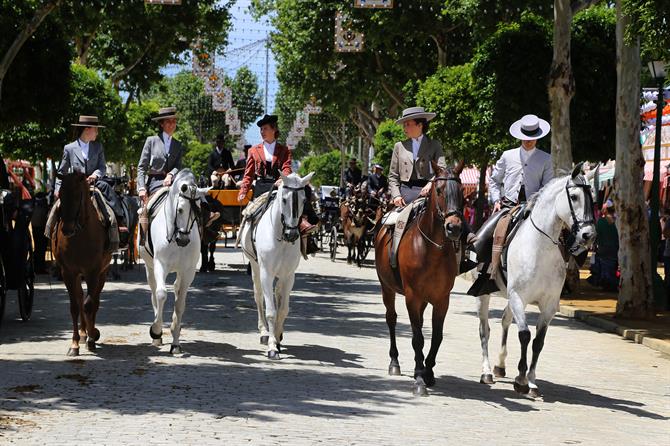
The Seville Feria was first established on 1846, when two entrepreneurs, Narciso Bonaplata and José María de Ybarra (curiously, neither from Seville), wrote to the City Council to propose an agricultural and livestock fair to be held in the city.
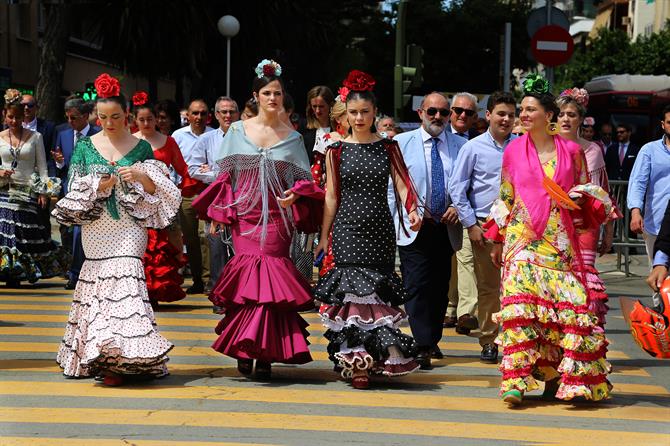
The first Feria started on 18th of April of the following year and apparently was an instant success; right after the event, the merchants were already asking the Council for a bigger police presence for the following edition, because the crowd, the music and the dances made it difficult for them to close their deals.
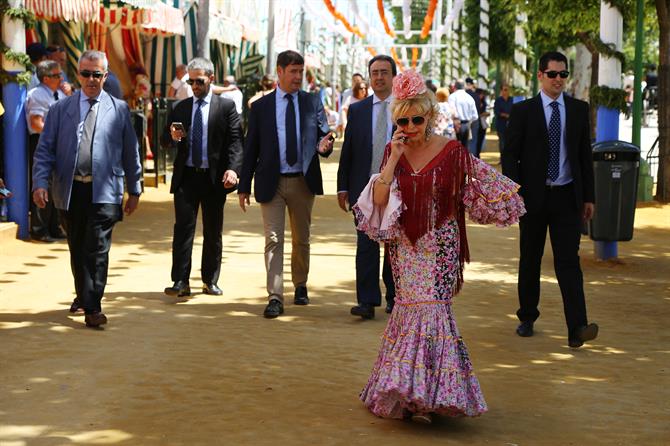
Over the years, leisure has become the only focus of the event, attracting hundreds of thousands of people every spring, eager for fun. The city is transformed and decorated for the occasion, offering an impressive spectacle. The streets flow with traditional clothes, carriages, flower decorations and flamenco musicians setting the scene. The cheerful atmosphere and excitement are palpable at every corner (and, of course, in every bar!); in Seville, the wait for this festive week continues to grow during the whole year.
Where and when?
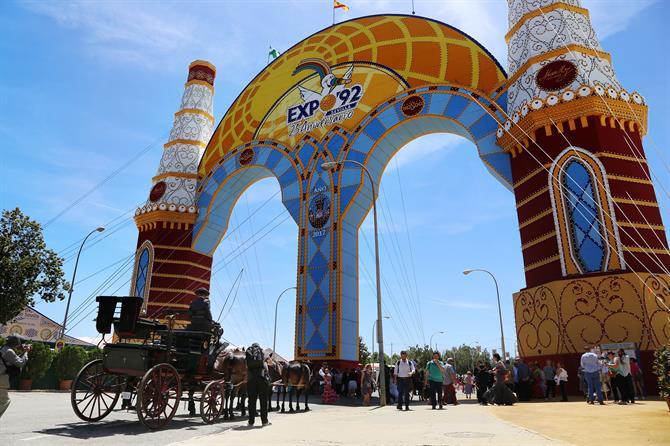
The unique atmosphere of the Feria can be sensed throughout Seville, but the main activity area since 1973 is the Recinto Ferial, a dedicated space of more than fifty thousand square metres located across the river just outside the centre, in an area called Los Remedios. If a stroll through the old town to enjoy the atmosphere and the beauty of the city is highly recommended, then a visit to the Recinto to experience the celebration in full with thousands of people is definitely a must.
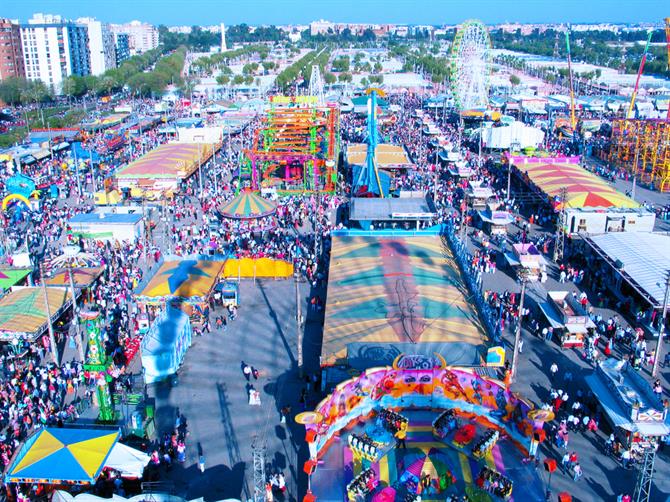
The Recinto was designed to be capable of accommodating the huge flow of visitors and to host more than a thousand casetas that make up the heart of the party. These are establishments managed by local institutions, organisations, associations or private groups (called peñas). Their design is inspired by the traditional stables used to host the animals during the first editions of the Feria. They offer almost uninterrupted sevillanas performances (the traditional Feria music and dance), great gastronomy and cultural activities of all kinds, and form a true "city within the city", comprising over a thousand buildings, along 15 streets.
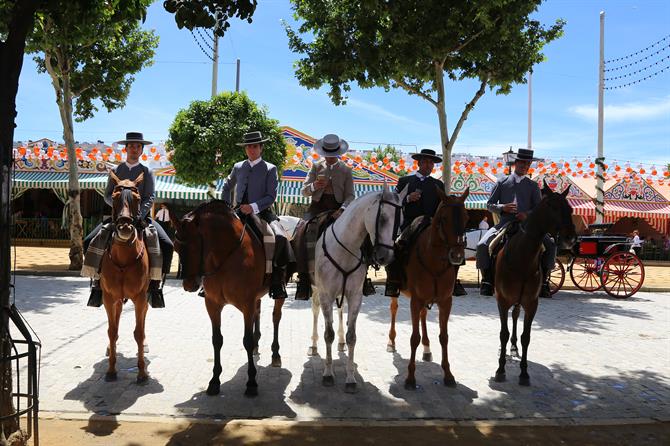
Unlike other Andalusian Ferias (like the Feria de Malaga), access to the casetas is in most cases restricted to members of the organisations that manage them, or people invited. If you're not lucky enough to fall in one of these categories, don't worry, you can enjoy the incredible atmosphere offered by 16 public casetas distributed around the area. There you can have as much fun as in the private ones (guaranteed!), and you could even end up getting to know some sevillanos who can invite you to a private establishment.
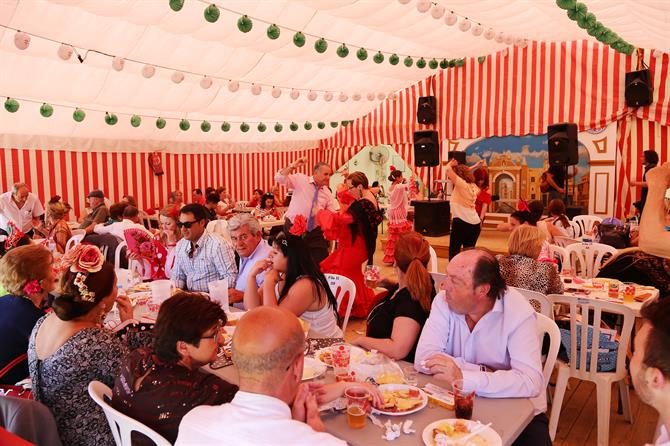
Depending on the year, the Seville fair starts one or two weeks after the end of the Semana Santa. The official start is marked by the traditional Alumbrado ceremony: on Sunday, around 22.00, the mayor of the city will turn on more than 22,000 light bulbs in the Portada de la Feria (the main access point of the fair). From that moment, and for six full days, nothing will be able to curb the desire to have fun.
How to live the Feria - Tips and information
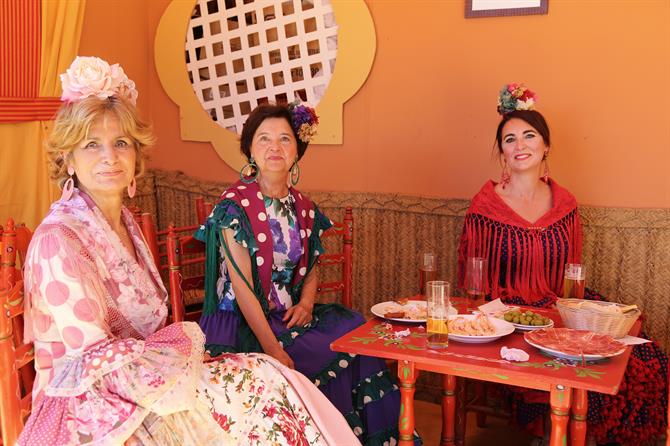
Being a traditional celebration, it's easy to feel like just a simple spectator. Despite the international fame and the great hospitality of the sevillanos, the Feria is still mainly an Andalusian festival, so if you want to enjoy the event to the full, and not just walk around overwhelmed by the spectacle, here is some basic information and tips that can help you to enjoy it a bit more like a local:
Dress code
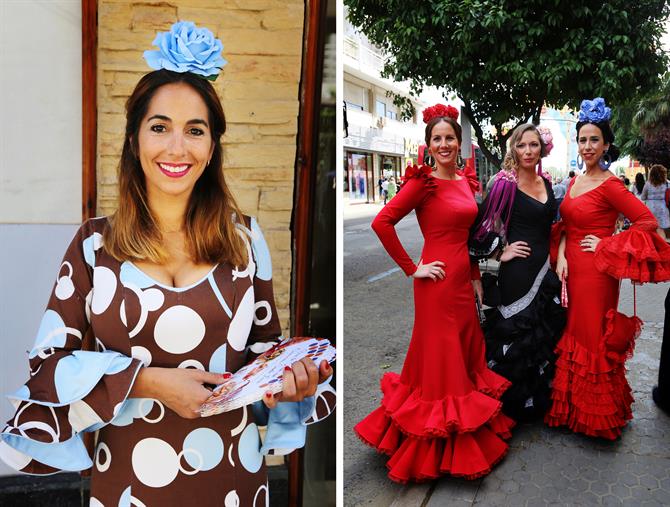
The Feria is one of those events for which the famous traje flamenco was invented. Around the Recinto, you'll see that the majority of women are wearing it. The traje corto (short jacket, hat and boots) is very popular among men, even if to less extent. It's not necessary to buy one to participate, but it's a good idea to add an accessory to your outfit to literally wear the Feria spirit: a flower, a man's hat, a fan or a pair of earrings will do the job, and will also be a nice souvenir.
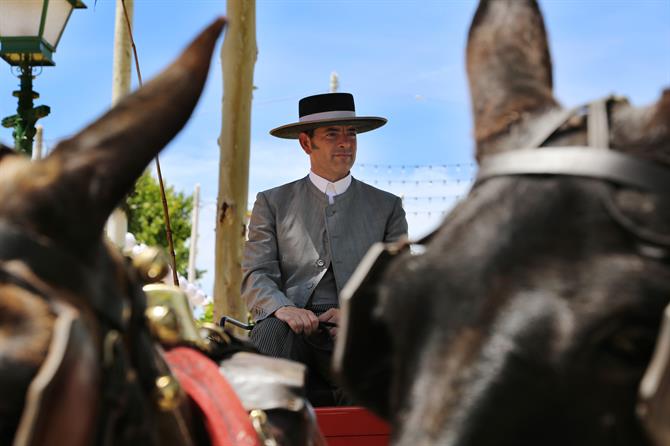
Keep in mind that you'll probably be standing for many hours (as well as the dancing, if you fancy it), and that the Recinto floor is made of a sort of yellow, sticky sand (called albero, the same used in the bullrings), so choose your footwear accordingly.
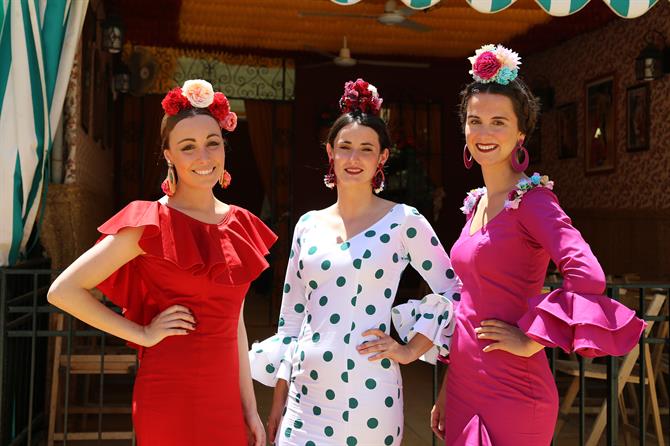
In general, there isn't a specific dress code, but consider that it's a important event for sevillanos, who tend to choose at least a casual outfit. Also, if you would like to be admitted into the private casetas, you may be asked to dress "appropriately" (no shorts or slippers, for example).
Not to be forgotten: temperatures during the Seville April Fair can be considerably high.
Food and drinks
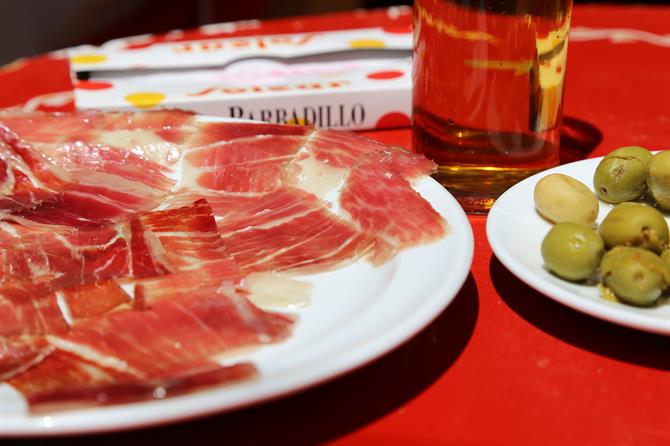
As expected, gastronomy has its own role during the Feria. Starting from the tradition of serving the pescaito (fried fish) during the alumbrado ceremony, the food and drinks symbolise the traditions and mark the social moments. All the casetas will offer you occasions to taste the most typical Andalusian dishes; enjoy them in the Andalusian way, sharing them with your friends (old and new). Don't miss the rebujito, the typical Feria drink, a refreshing mix of vino fino (dry white wine) and lemonade.
When to go
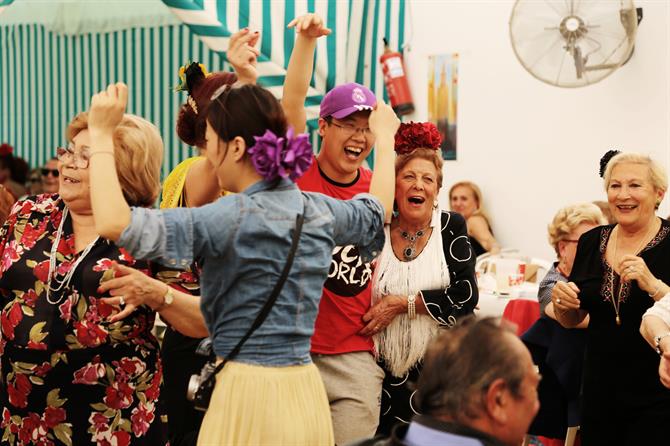
Virtually, the party never stops. You will find people and music almost all day and night long, both in the centre and in the Recinto. The most crowded and exciting moments are the alumbrado, the very start of the Feria, and the firework show, on the final night.
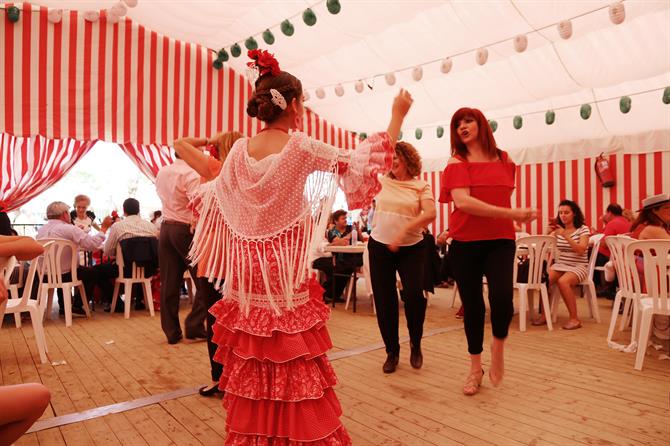
Every day, the Recinto usually starts to get animated after 2:00 pm, when the casetas start to serve food and drinks, after a break of a few hours. After 8:00 pm, the horses and carriages cannot be in the Feria ground; it is usually around this time that crowds of youngsters start coming in.
Kids
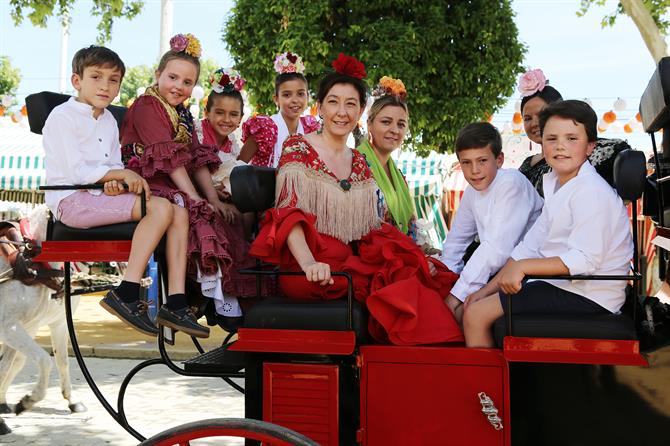
Despite the dimensions of the celebration, the fair is actually a kid-friendly event. The little ones will enjoy the colours, the carriages and the atmosphere as much as the adults. You will find many attractions dedicated to them in Calle del Infierno, a fairground located next to the main casetas area of the Recinto. It offers over 400 establishments with activities, rides and shows, perfect for children.
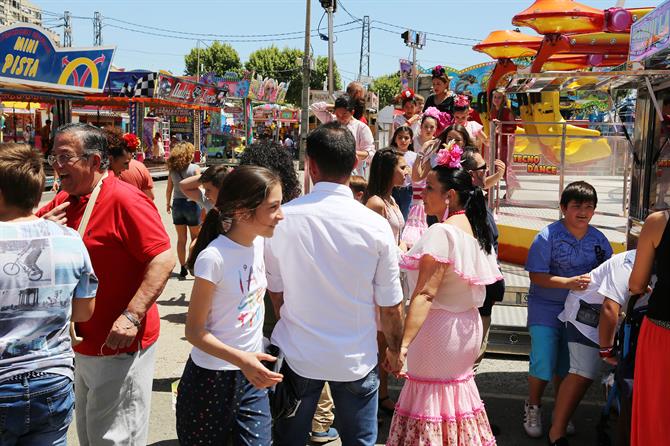
(A service for lost kids has been put in place. A dedicated caseta, called Caseta de Niños Perdidos is located in Calle Gitanillo de Triana, n°126; telephone number: +34 954 459 189.)
Transport
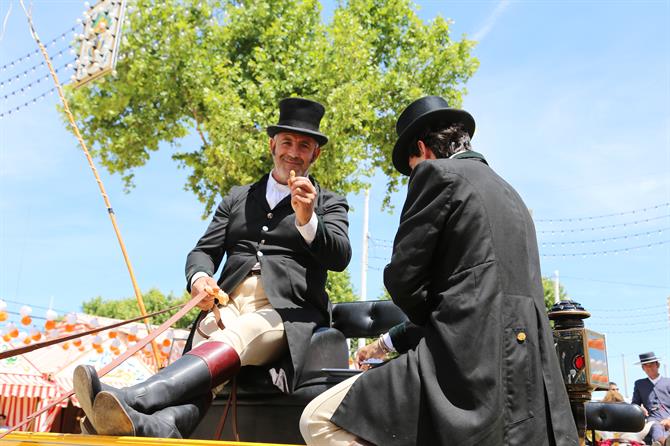
Using public transport is almost mandatory unless you want to deal with impossible traffic and lack of parking. You can use taxis, metro or bus.
Bus - There is a special service to get to the Recinto Ferial. It operates every day from 12:00 pm until 7:00 am without interruptions (ticket price: 1,60€). It leaves from a bus stop called "Prado de San Sebastián", located right next to the city's bus station.
You can get to the Recinto also with several standard bus lines (again with services operating from 12:00 pm to 7:00 am): C1, C2, 3, 5, 6, 10, 11, 15, 16, 20, 21, 22, 25, 26, 27, 28, 29, 30, 31, 34, 37, 38A, 41, 52. You can get full information about itineraries and prices on the official page of the transport company.
Metro - The line to get to the Recinto is the n°1 (direction: "Ciudad Expo - Olivar de Quintos"). The stops close to the main entrance are: "Blas Infante", "Parque de Los Principes" or "Plaza de Cuba". Also, in this case, the service doesn't stop during the night.
The Feria de Abril is an opportunity not to be missed to get to know these beautiful places and their fascinating traditions. The Andalusian capital is easily accessible; all the main low-cost airlines guarantee daily flights from major European cities to the city airport, or to nearby Jerez de la Frontera, and you can take advantage of the many apartments for rent in the province of Seville to start discovering authentic Andalusia.
